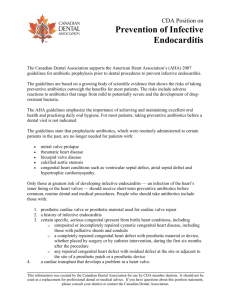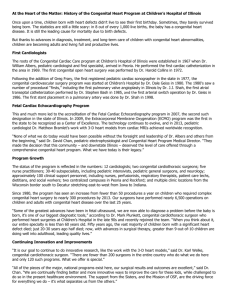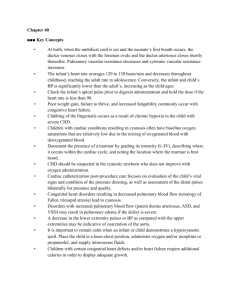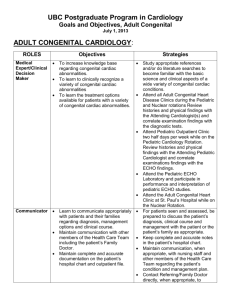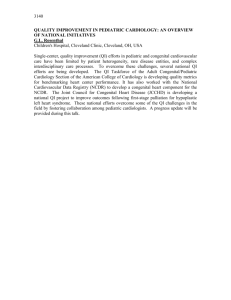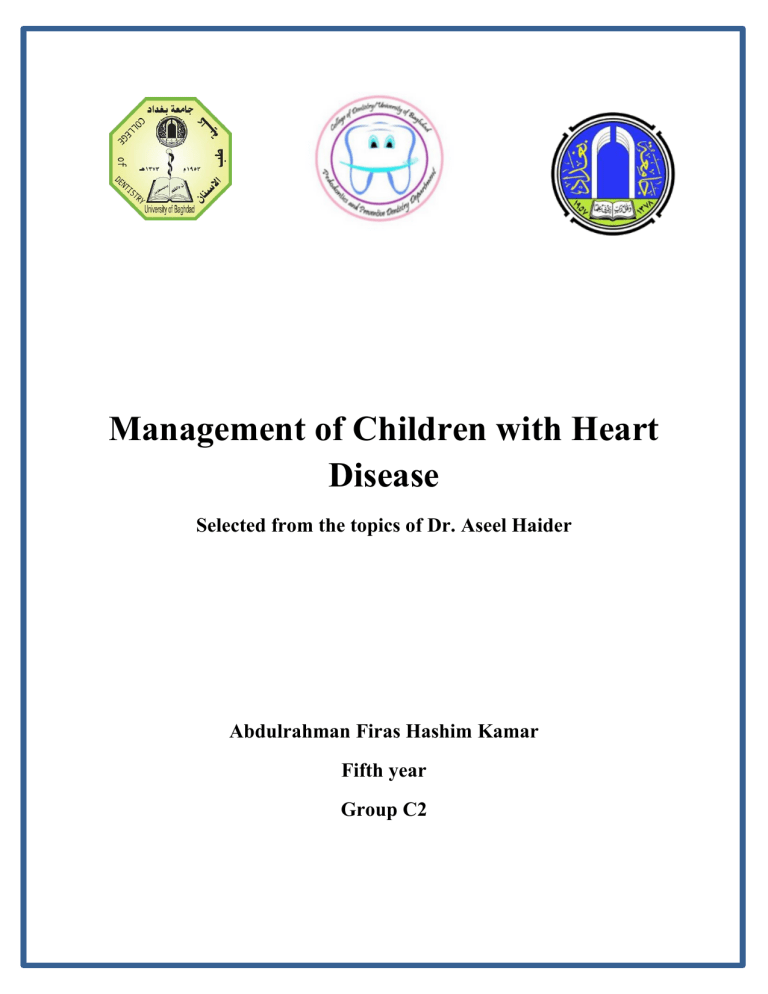
Management of Children with Heart Disease Selected from the topics of Dr. Aseel Haider Abdulrahman Firas Hashim Kamar Fifth year Group C2 Management of children with Heart Disease Introduction Heart disease can be divided into two general types congenital and acquired. Because individuals with heart disease may require special precautions during dental treatment, such as antibiotic coverage for prevention of infective endocarditis (IE), a dentist should closely evaluate the medical histories of all patients to ascertain their cardiovascular status. In April 2007 the American Heart Association presented recommendations to conserve the use of antibiotics for the prevention of IE to minimize the risk of developing resistance to current regimens. CONGENITAL HEART DISEASE The incidence of congenital heart disease is approximately 9 in 1000 births. The cause of a congenital heart defect is obscure. Generally it is a result of aberrant embryonic development of a normal structure or the failure of a structure to progress beyond an early stage of embryonic development. Only rarely can a causal factor be identified in congenital heart disease. Maternal rubella and chronic maternal alcohol abuse are known to interfere with normal cardiogenesis. If a parent or a sibling has a congenital heart defect, the chances that a child will be born with a heart defect are about 5 to 10 times greater than average. Congenital heart disease can be classified into two groups: acyanotic and cyanotic. Acyanotic Congenital Heart Disease Acyanotic congenital heart disease is characterized by minimal or no cyanosis and is commonly divided into two major groups. The first group consists of defects that cause left-to-right shunting of blood within the heart. This group includes ventricular septal defect and atrial septal defect. Clinical manifestations of these defects can include congestive heart failure, pulmonary congestion, heart murmur, labored 1 breathing, and cardiomegaly. The second major group consists of defects that cause obstruction (e.g., aortic stenosis and coarctation of the aorta). The clinical manifestations can include labored breathing and congestive heart failure. Cyanotic Congenital Heart Disease Cyanotic congenital heart disease is characterized by right-to-left shunting of blood within the heart. Cyanosis is often observed even during minor exertion. Examples of such defects are tetralogy of Fallot, transposition of the great vessels, pulmonary stenosis, and tricuspid atresia. Clinical manifestations can include cyanosis, hypoxic spells, poor physical development, heart murmurs, and clubbing of the terminal phalanges of the fingers. ACQUIRED HEART DISEASE Rheumatic Fever Rheumatic fever is a serious inflammatory disease that occurs as a delayed sequela to pharyngeal infection with group A streptococci. Rheumatic fever is a commonly diagnosed cause of acquired heart disease in patients under 40 years of age. The mechanism by which the group A Streptococcus strains initiate the disease is unknown. The infection can involve the heart, joints, skin, central nervous system, and subcutaneous tissue. Although rheumatic fever can occur at any age, it is rare in infancy. It appears most commonly in children between the ages of 6 and 15 years. Rheumatic fever is most prevalent in temperate zones and at high altitudes and is more common and severe in children who live in substandard conditions. 2 Infective Endocarditis (IE) It is one of the most serious infections of humans. It is characterized by microbial infection of the heart valves or endocardium in proximity to congenital or acquired cardiac defects. IE has been classically divided into acute and subacute forms. The acute form is a fulminating disease that usually occurs when microorganisms of high pathogenicity attack a normal heart, causing erosive destruction of the valves. Microorganisms associated with the acute form include Staphylococcus, group A Streptococcus, and Pneumonococcus. In contrast, subacute IE usually develops in persons with preexisting congenital cardiac disease or rheumatic valvular lesions. Surgical placement of prosthetic heart valves can also predispose a patient to IE; heart valve infections occur in 1% to 2% of such patients. The subacute form is commonly caused by viridans streptococci, microorganisms common to the flora of the oral cavity. Embolization is a characteristic feature of IE. Microorganisms introduced into the bloodstream may colonize the endocardium at or near congenital valvular defects, valves damaged by rheumatic fever, or prosthetic heart valves. The clinical symptoms of IE include low, irregular fever (afternoon or evening peaks) with sweating, malaise, anorexia, weight loss, and arthralgia. Inflammation of the endocardium increases cardiac destruction, and murmurs subsequently develop. Painful fingers and toes and skin lesions are also important symptoms. Infective Endocarditis Prophylaxis Transient bacteremia is an important initiating factor in IE. So, procedures known to precipitate transient bacteremias in dentistry IE prophylaxis is recommended for. Dentist should consider the use of antibiotics in patients with underlying cardiac conditions for all dental procedures that involve manipulation of gingival tissue, involvement of the periapical area or perforation of oral mucosa. The recent AHA revision concluded that only a small number of cases of IE might be prevented by 3 antibiotic prophylaxis for dental procedures, even if such prophylactic therapy were 100% effective. Antibiotic Prophylaxis Previously, the 1997 guidelines recommended prophylactic antibiotics for patients in high-risk aid moderate-risk categories. The 2007 guidelines now recommend that only patients in this high-risk category require coverage. Amoxicillin remains the first choice as the prophylactic antibiotic. In 1997, amoxdcillin was to be administered 1 hour before the procedure. The 2007 guidelines recommend administration of amoxicillin (and any other recommended antimicrobial) 30 to 60 minutes before the procedure. According to the revised guidelines by AAPD (2011), minimal use of antibiotics is indicated to avoid the risk of developing resistance due to antibiotic usage. It will also be worthwhile to mention that medically compromised patients with noncardiac factors may also have a compromised immune system and may not be able to tolerate transient bacteremia following any invasive dental procedure. This category may include diseases secondary to immunosuppression such as AIDS, HIV, autoimmune diseases, post radiotherapy, prolong use of steroid and metabolic disorders such as diabetes by AHA for prevention of infective endocarditis. Any dental patient who has a history of congenital heart disease or rheumatic heart disease or who has a prosthetic heart valve should be considered susceptible. Heart conditions are associated with the highest risk of adverse outcomes from IE: 1- Prosthetic cardiac valve or prosthetic material used for cardiac valve repair. 2- Previous infective endocarditis. 3- Congenital heart disease (CHD). 4- Unrepaired cyanotic CHD, including palliative shunts and conduits. 4 5- Completely repaired congenital heart defect with prosthetic material or device, whether placed by surgery or by catheter intervention, during the first 6 months after the procedure. 6- Repaired CHD with residual defects at the site or adjacent to the site of prosthetic patch or prosthetic device (which inhibits endothelialization) Cardiac transplantation recipients who develop cardiac valvulopathy. Dental management Parents of patients with cardiac risks typically lack knowledge about IE even after being informed during routine cardiology visits. Before initiating care, the dentist should obtain a thorough medical and dental history, perform a physical examination, formulate a complete treatment plan, and discuss the treatment with the child’s physician or cardiologist. Behavior management techniques are useful, and conscious sedation and nitrous oxide–oxygen analgesia have also been proven beneficial in reducing anxiety in such patients. Conscious sedation monitoring and cardiopulmonary resuscitation equipment should be readily available during the appointment. If general anesthesia is indicated, the dental procedures should be completed in a hospital setting, where adequate supportive care is available if needed. Important considerations in treating patients who are susceptible to IE 1. Pulp therapy is not recommended for primary teeth with a poor prognosis because of the high incidence of associated chronic infection. 2. Endodontic therapy in the permanent dentition can be accomplished successfully if the teeth selected carefully and the endodontic therapy is adequately performed. 3. A dentist who feels uncomfortable in treating patients who are susceptible to IE has a responsibility to refer them to someone who will adequately care for them. 5 References 1. Wilson W, et al.: Prevention of infective endocarditis: guidelines from American Heart Association, Circulation 116: 1736–1754, 2007. 2. Hayes PA, Fasules J: Dental screening of pediatric cardiac surgical patients, J Dent Child 68:255–258, 2001. 3. Marwah, N., 2014, Textbook of pediatric dentistry, third edition. 4. Jeffrey A. Dean, 2015, Mcdonald and Avery`s Dentistry for the child and adolescent, tenth edition. 5. Dickstein K, Cohen-Solal A, Filippatos G, McMurray JJ, Ponikowski P, Poole-Wilson PA, et al. ESC guidelines for the diagnosis and treatment of acute and chronic heart failure 2008: The task force for the diagnosis and treatment of acute and chronic heart failure 2008 of the European Society of Cardiology. Developed in collaboration with the Heart Failure Association of the ESC (HFA) and endorsed by the European Society of Intensive Care Medicine (ESICM) Eur J Heart Fail. 2008; 10:933–89. 6. Hsu DT, Pearson GD. Heart failure in children: Part I: History, etiology, and pathophysiology. Circ Heart Fail. 2009; 2:63–70. 7. Kay JD, Colan SD, Graham TP., Jr Congestive heart failure in pediatric patients. Am Heart J. 2001; 142:923–8. 8. Rossano JW, Kim JJ, Decker JA, Price JF, Zafar F, Graves DE, et al. Prevalence, morbidity, and mortality of heart failure-related hospitalizations in children in the United States: A population-based study. J Card Fail. 2012; 18:459–70. 9. Towbin JA, Lowe AM, Colan SD, Sleeper LA, Orav EJ, Clunie S, et al. Incidence, causes, and outcomes of dilated cardiomyopathy in children. JAMA. 2006; 296:1867–76. : توقيع الطالب عبدالرحمن فراس هاشم قمر

